Abstract
The Internet of Things (IoT) has enabled the development of various applications for energy, exploiting unprecedented data collection, multi-stage data processing, enhanced awareness, and control of the physical environment. In this context, the availability of tools for efficient development is paramount. This paper explores and validates the use of a generic, flexible, open-source measurement-oriented data collection framework for the energy field, namely Measurify, in the Internet of Things (IoT) context. Based on a literature analysis, we have spotted three domains (namely, vehicular batteries, low voltage (LV) test feeder, and home energy-management system) and defined for each one of them an application (namely: range prediction, power flow analysis, and appliance scheduling), to verify the impact given by the use of the proposed IoT framework. We modeled each one of them with Measurify, mapping the energy field items into the abstract resources provided by the framework. From our experience in the three applications, we highlight the generality of Measurify, with straightforward modeling capabilities and rapid deployment time. We thus argue for the importance for practitioners of using powerful big data management development tools to improve efficiency and effectiveness in the life-cycle of IoT applications, also in the energy domain.
1. Introduction
A measurement-oriented data management framework systematically collects, processes, and stores Internet of Things (IoT) sensor-based data to ensure accuracy, consistency, and usability for analytics. Such a framework encompasses data acquisition, preprocessing, storage, and retrieval, facilitating real-time monitoring and informed decision making, similar to human-cognition-inspired condition management systems [1]. State-of-the-art condition monitoring assesses system health by continuously measuring the structural, environmental, and operational attributes of equipment and infrastructure. It relies on structured data pipelines and real-time analytics to derive meaningful insights. In this context, a measurement-oriented framework enables the efficient deployment of IoT services and modules such as fault detection, failure diagnostics, and prognostics for optimized maintenance [2,3,4]. These capabilities are particularly relevant in the energy sector, where IoT technologies are widely utilized to enhance monitoring, improve efficiency, and inform decision making. Literature reports several applications of IoT technologies in the energy sector, many of which concern power grid management. A cloud-based IoT solution for fault detection and localization was used in power distribution systems in [5]. In [6], dynamic pricing under thresholding policies was used to reduce the peak consumption and better match the demand to supply smart grids. Energy consumption in residential buildings accounts for around 30–40% of the total energy use worldwide [7]. Therefore, home energy-management systems (HEMS) can be a valuable tool for reducing significant electricity expenses. An energy-efficient scheduling algorithm for demand-side management in smart grids has achieved significant monetary savings [8]. The influence of dynamic electricity tariffs and grid charge designs on residential consumer savings, tariff choices, and low-voltage grid reinforcement needs to support renewable energy integration was presented in [9]. Two-stage home energy-management system, utilizing day-ahead electricity pricing tariffs, achieves an average cost reduction of 8.7%, as demonstrated in [10]. A LSTM-based sequence-to-sequence model for appliance-level short-term load forecasting in residential buildings was proposed in [11].
As energy-related applications gain increasing relevance, there is a growing need for tools that enable the efficient and effective development of applications leveraging the vast data generated by the IoT [12,13,14]. Insights derived from IoT-connected devices are being utilized to develop new services, enhance real-time decision making, improve efficiency, address critical challenges, and create innovative user experiences. Additionally, IoT applications can provide significant benefits to energy-intensive manufacturing enterprises by optimizing energy consumption, reducing operational costs, and improving overall sustainability.
For instance, in [15], an Elman recurrent neural network was utilized to estimate the state of charge (SOC) and state of health (SOH) of lithium-ion batteries, leveraging its contextual memory for improved prediction accuracy. Wei et al. developed an online model to estimate the remaining driving range using real-world BEV data from Beijing, analyzing driving cycles and energy consumption to identify an optimal driving speed for maximum efficiency in [16]. A cloud-based battery condition monitoring platform was used to improve the scalability, cost-effectiveness, safety, reliability, and optimal operation of large-scale battery energy storage systems in [17]. A cloud based IoT-enabled dynamic wireless charging metering service for electrical vehicles was realized in [18,19].
In various domains, problems, and technological solutions, we observe a lack of literature on works that consider the efficient development of cloud-based solutions for the seamless management of energy IoT data. This paper thus investigates the usefulness of a generic, cloud-based, measurement-oriented data collection system. We argue that the concept of measurement is at the very basis of the IoT paradigm, and that collecting and managing data through a tool built on this concept can enhance the development of applications. Based on a preliminary literature survey, we focused our research on three major energy application domains: vehicular batteries, low voltage (LV) test feeders, and home energy management. As a tool, we use Measurify (previously known as Atmosphere), a non-vendor-locked, open source measurement-oriented framework for managing bright things in IoT ecosystems [20]. The tool has been developed and tested in the automotive [19,21,22] and health domains [23]. We are interested in understanding its effectiveness in the broader energy domain. Measurify provides a RESTful application programming interface (API) [24] coded in Node.js. Node.js avoids the multi-threading burden by employing a non-blocking, single-threaded pattern and can efficiently serve multiple concurrent clients by operating asynchronously, utilizing the event-loop mechanism. For data management, the framework exploits the underlying MongoDB database and its seamlessly usable Mongoose persistence layer. A workflow for optimizing the integration of CSV files into MongoDB storage within the Measurify IoT application framework, facilitating the creation of application-specific resources, was proposed in [25] and evaluated in [26]. From an architectural perspective, the primary requirements concern scalability, reusability, ease of deployment, data integrity preservation, and adherence to cross-domain standard IoT terminology. Measurify supports custom resource-type design, user/group, and right management.
The remainder of the paper is structured as follows: Section 2 characterizes the three targeted energy IoT application domains, based on literature analysis. For each one of these domains, an IoT data-rich service is chosen as an exemplary application, and Section 3 presents the modeling of those services through the Measurify framework. Experimental results are presented in Section 4. Section 5 concludes and indicates possible future work.
2. Energy Data Characterization in the Three Target Domains
IoT environments generate and utilize vast amounts of data. Handling these data effectively and gaining meaningful insights from it needs a deep understanding of their domains. To this end, we performed an extensive literature review and analyzed publicly available datasets. As anticipated, we focus on applications in three major energy domains: vehicular batteries, smart grids, and building management.
2.1. Vehicular Batteries
Among the market of available batteries for electric vehicles (EVs), lithium-ion batteries feature high energy density, high power density, long service life, fast charging, a lower self-discharge rate, and environmental friendliness, and thus have found wide application in the area of consumer electronics [27]. The evaluation of the state of batteries in electric vehicles is essential to optimize the energy-management strategy, extend the life cycle, reduce costs, and ensure safe application of batteries in electric vehicles [28]. The primary purpose of a battery management system (BMS) is to ensure safe and optimal use of the battery energy and provide accurate battery state information for the EV’s overall energy management. Alongside this, the BMS should have the capability to give proper interventions for the battery system if it is working in an abnormal condition, such as overcharging or overdischarging. Overcharging of batteries can pose significant safety issues, leading to chemical degradation and short circuits that can cause fires and release hazardous gases. In a similar way, the over-discharging can damage the battery and shorten its lifetime by more than 50%. Precise battery measurement focuses on smaller unit measurements, with millivolt and milliamp accuracy, and time-synchronising these voltages and currents [29]. Accurate and reliable battery state estimation is a critical tool for boosting the lifespan of the battery packs from 10 years to 20 years in the best case and generally result in a 30% lifetime improvement [30].
BMSs are well-established in portable electronic devices, such as cellular phones and laptops. However, the implementation of BMS in EVs is still in the early stage because the number of cells in an EV is a hundred times higher than on portable devices. EV battery banks are designed to provide high voltage, current, and power, which makes the BMS more complex than that of portable electronics. Figure 1 shows a typical EV BMS and its data flow within a battery pack. The functional module comprises both hardware and software components for data collection. The hardware structure includes various sensors, actuators, controllers, storage, and signal lines. In contrast, the software perspective encompasses measurement data parameters, state calculation algorithms (analytics tools) and methods, user interface (visualization), fault detection, and monitoring mechanisms. The monitoring blocks (bus voltage, total current, cell voltage, temperature detection, and smoke detection) collect real-time battery data, which is processed by the control circuit to determine state-of-charge (SOC) and state-of-health (SOH). The protection module uses these data to prevent hazardous conditions (over/under voltage/current) by triggering safety measures. The communication blocks relay battery status to the vehicle controller and display terminal for user feedback and system adjustments. Meanwhile, the cell balancing blocks (passive/active) distribute charge evenly across cells based on monitored data, while the thermal management system (cooling/heating) adjusts temperature to maintain optimal performance. Data flows bidirectionally—from sensors to control units and back to actuators—ensuring safe, efficient, and balanced battery operation. After sampling and preprocessing, the measured data are forwarded to both the control circuit and the data storage. As a sample service implementation in this area, exploiting the Measurify IoT data framework, Section 3.1 analyzes a module for the estimation of the battery SoC and EV range prediction.
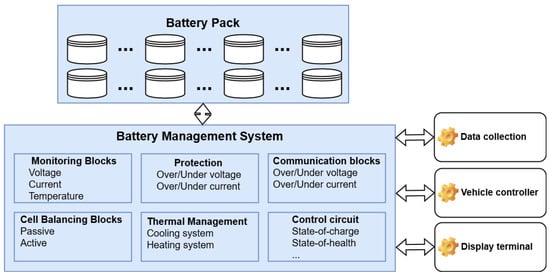
Figure 1.
Schematic representation of a battery management system (BMS) architecture for electric vehicle battery packs.
2.2. LV Test Feeder
An LV feeder is a part of the electrical distribution system that delivers power from a distribution transformer to end-users, such as homes, businesses, or small industrial facilities. Structure of a low-voltage distribution grid connected to the medium-voltage grid through a transformer is presented in Figure 2. Smart meters are used as sensors to measure household or small commercial loads. The sensor measures the energy usage data and forwards them to storage. The measurements collected from an LV feeder are then used to feed services for power flow analysis. The LV test feeder is a radial distribution system operating at a base frequency of 50 Hz [31]. It is connected to the medium voltage network via a substation transformer, which steps down the voltage from 11 kV to 416 V. Both the main feeder and its laterals operate at 416 V.
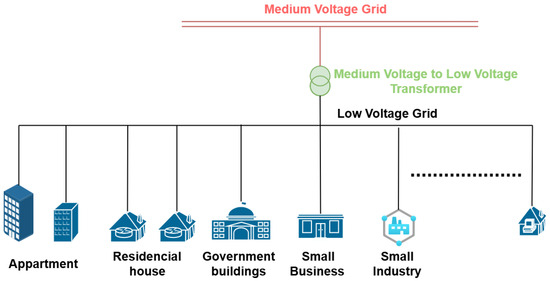
Figure 2.
The low-voltage grid supplies electricity to various consumer types, including apartments, residential houses, government buildings, small businesses, and small industries.
Data collected from the LV feeder distributor can be used to generate insights on market trends, consumer behavior, system health, and critical alarms. By leveraging that dataset, various researchers modeled real-world scenarios, optimized grid efficiency, and enhanced voltage stability [32,33]. These analyses are crucial to improving the reliability of the distribution system, integrating renewable energy sources, and ensuring the smooth operation of the feeders. Interactive information sharing between feeder distributors and consumers allows better scheduling and energy management. Among those services, we chose power flow analysis because it enables the simulation of voltage drops, power losses, and load distribution in feeder networks, allowing engineers to assess system performance under various operating conditions. Section 3.2 presents a stepwise functional methodology for calculating power loss in the low-voltage (LV) feeder.
2.3. Home Energy-Management System (HEMS)
A HEMS is an innovative system that monitors, controls, and optimizes energy usage in a household. It integrates various devices, including smart meters, appliances, renewable energy sources, energy storage systems, and demand-side management strategies, to improve energy efficiency and reduce costs [34]. HEMS typically utilizes automation, data analytics, and machine learning to schedule appliance operations, balance power consumption, and capitalize on time-of-use electricity pricing. It can also enhance grid stability by coordinating energy consumption with fluctuations in supply. According to Ruano et al., HEMS can be managed in four stages [35]. The first stage collects data, including electrical readings such as current, voltage, and power, which are measured by smart meters or acquisition boards, or by using specialized sensors. In the second stage, namely the event detection, any change in the state of an appliance over time was noticed through thresholding based on historical data. In the third stage, feature extraction was performed for each appliance based on its load signature. Finally, in the fourth stage, the load was identified by using the extracted features.
The introduction of smart metering produces fine-grained energy consumption data, allowing for the extraction of more valuable information on energy demand and production compared to having only an energy balance over an extended period. A precise demand-response functionality is expected to benefit from a much finer granularity of information, such as appliance load monitoring [36]. The appliance load monitoring focuses on implementing detailed energy sensing and delivering information on the breakdown of the energy spent. There are two major approaches to appliance load monitoring: intrusive load monitoring (ILM) and non-intrusive load monitoring (NILM), which differ based on the number of sensors used. ILM, also referred to as distributed sensing, performs different activities such as occupancy detection, behavior monitoring, and contextual sensing. In NILM, on the other hand, only power consumption by an appliance as a single measurement is sensed. The ILM method is more accurate in measuring appliance-specific energy consumption; however, it is less widespread due to several practical difficulties, including multiple sensor configurations, high costs, and complex multimodal analysis and decision making.
HEMS performs appliance scheduling and analytics locally via onboard controllers, but the cloud storage offers several complementary benefits. It enables long-term data retention, remote monitoring, system updates, and advanced analytics using centralized machine-learning models. Additionally, cloud infrastructure supports scalability, allowing integration with utility demand-response programs and cross-household energy optimization—capabilities that may exceed the processing and storage limitations of local controllers. A typical NILM data collection framework for HEMS is depicted in Figure 3. Electrical appliances, such as computers, ovens, and washing machines, are monitored using sensors or meters to measure electrical quantities (e.g., current, voltage, power). Parameters like sampling rate and accuracy influence these measurements. Data are transmitted via communication protocols (e.g., ZigBee, MQTT, HTTP) to a central server, stored in various file formats (e.g., CSV, HDF5, WAVE), and used for HEMS analytics, including appliance scheduling and load forecasting.
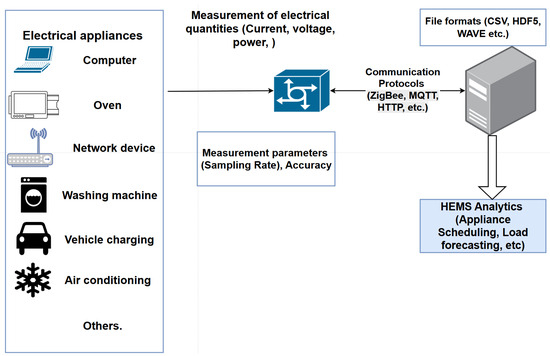
Figure 3.
Overview of a home energy-management system (HEMS) architecture for appliance-level monitoring and analytics.
The HEMS should offer advantages to both residential occupants and electricity suppliers, enabling better exploitation of power sources. For electricity suppliers, two-way communication enables a more efficient organization of the network and the implementation of several demand response mechanisms to dynamically control load based on capacity analysis, emergency demand response, and supplementary service analysis by suppliers. Nowadays, dynamic electricity retail tariffs are commonly used to support renewable energy integration, allowing residential occupants to reduce their electricity costs by scheduling appliance usage efficiently. Section 3.3 presents an appliance scheduling method to recommend optimum hours for high electricity-consuming appliances.
3. Services Based on IoT Measurements
In this section, for each of the domains described above—vehicular batteries, LV feeder, and HEMS—we address a significant problem and explore how a relevant cloud-based service, drawn from the literature, can be built using a measurement-oriented framework such as Measurify.
Before going into detail, we briefly present the generic design workflow supported by Measurify. The first step in the workflow consists of domain modeling, where the domain field objects are mapped to Measurify API’s resources, each one with its schema, which are accessible through the API routes. Table 1 provides an overview of the primary Measurify resources. Once a Measurify installation is configured with the domain-specific instantiation of the configuration resources (i.e., features, things, devices and tags), the system is ready to receive data (i.e., measurements) in JSON format from the field through the common RESTful APIs. For the sake of data integrity verification, Measurify is responsible for ensuring that each received measurement is formatted according to its corresponding format. Measurify is in charge of verifying. More information can be found in [20].

Table 1.
Outlook of the Measurify resource types.
For the reader’s convenience, Section 3.4 provides a synopsis of three IoT services: EV range prediction, power flow analysis, and appliance scheduling, including data characterization and mapping with Measurify resources.
3.1. Range Prediction
Range prediction is a complex and challenging problem that depends on numerous influential factors. A data-driven energy consumption prediction method for EVs, developed in [37] for energy-efficient routing, has demonstrated both high prediction accuracy and ease of use. Several parameters influence the range of vehicles, including state of charge (SoC), ambient temperature, driving behavior, route, and traffic, as shown in Figure 4. The weightage of influencing parameters on EV range prediction has the following values: 54% SoC, 25% ambient temperature, 10% driver behavior, 6% route, 5% traffic, according to [38]. The accuracy of the estimated range for an electric vehicle (EV) mainly depends on the accuracy of the state of charge (SoC) estimation. The driving range depends upon both estimating the remaining energy in the battery and predicting the future energy consumption pattern of the remaining trip.
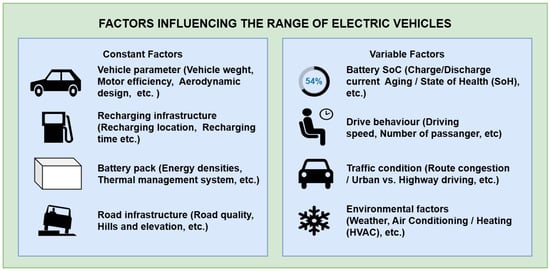
Figure 4.
The main influence factors on EV’s range (constants and variables).
The SoC of a battery indicates the level of charge remaining in percentage compared to its maximum available capacity. It is a crucial parameter for the charging/discharging strategies to protect the battery from overcharging/overdischarging. In [39], the authors critically analyzed the various algorithms for estimating the Li-ion battery state of charge (SoC). The real-time, accurate estimation of SoC in EVs is challenging because of the strong time-variables and nonlinear characteristics with the driving loads and operational conditions [28]. Open-circuit voltage (OCV) profiles play a crucial role in SoC estimation as they provide a direct relationship between voltage and battery capacity. During charging and discharging, the OCV changes with SoC due to battery chemistry, hysteresis effects, and ageing, making accurate profiling essential for precise estimation. By leveraging OCV-SoC characteristics, BMS can improve SoC accuracy. Charging and discharging events are best detected and managed locally by onboard energy-management systems. However, characterizing and understanding the voltage hysteresis phenomenon observed during these cycles provides valuable insights into battery degradation trends. A difference between the open-circuit voltage (OCV) curves during charging and discharging indicates voltage hysteresis, often caused by kinetic limitations, phase transitions, or irreversible electrochemical reactions. This hysteresis reflects energy loss and can signal reduced efficiency or degradation mechanisms within the battery.
To see the characteristics OCV during charging and discharging we can gain the relationship between voltage range and SoC as in Figure 5. The fifth cycle of charging and discharging from the Li-ion battery B0005, taken from the battery ageing datasets, is used to visualize the graph [40]. The maximum charging voltage reaches 4.2 V, while the discharge voltage drops to 2.7 V. The charging OCV is higher than the discharging OCV due to voltage hysteresis, internal resistance, and electrochemical reaction dynamics, causing polarization effects and ion transport limitations.
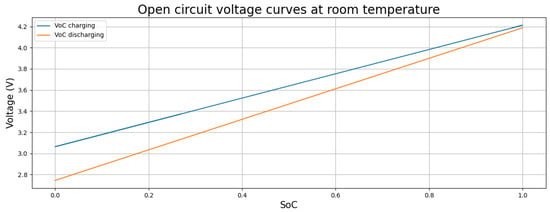
Figure 5.
Open-circuit voltage profiles of a lithium-ion B0005 battery during the fifth cycle of charging and discharging at room temperature.
It is a complete case for SoC estimation from BMS as in [17], but we move further to predict a range of EVs. Most studies regarding range estimation focus on predicting variable energy consumption and assume the remaining energy in the battery, in the form of SoC and state of health (SoH). Tannahill et al. proposed a range estimation method incorporating environmental and behavioral factors, along with SoC and vehicle efficiency, yielding greater accuracy than traditional SoC-based approaches [41]. A data-driven approach integrates real-world driving, geographical, and weather data to predict energy consumption across a road network. This method reduces error in multiple linear regression models to 12–14% of average trip consumption, with 7–9% attributed to SoC estimation [37].
The force required to move the electric vehicle, also known as the tractive force, is given by Equation (1) as the sum of the gravitational force, aerodynamic drag, and rolling resistance.
where m is the mass of the vehicle, g is the gravitational acceleration, is the air density, is the drag coefficient, A is the vehicle’s frontal area, v is the speed, is the frontal wind speed, and cr is the rolling resistance coefficient. The necessary power delivered by an engine to travel a distance while the vehicle maintains a desired acceleration and speed is given by the following Equation (2).
For simplicity, we assume, in the first order, that the rolling resistance coefficient, drag coefficient, air density, and vehicle mass are constant. The energy consumption can be described as a linear combination of the kinematic parameters , , , and h = ds sin as in [42]. To represent the consumption of the auxiliaries, the formula was then extended with a time-linear, temperature-scaled term.
Block diagram of range prediction system’s workflow is illustrated in Figure 6. The methodology employed in this study integrates real-world physics-based computations to analyze vehicle energy consumption, incorporating aerodynamic drag, rolling resistance, and inertial forces. A data-driven approach utilizing linear regression is applied to predict future range and energy depletion based on historical trip data. Furthermore, the methodology includes visualization techniques to assess trip efficiency, enabling a comprehensive evaluation of energy usage patterns for electric vehicle performance analysis. It begins by defining EV and environmental constants while loading trip data, including battery and drive cycle data. The data undergo preprocessing (resampling and imputation), followed by computing elevation, time difference, and distance. Aerodynamic and inertial forces are then calculated, leading to the computation of overall energy consumption, including regenerative braking effects. The system generates time-series data for SoC, distance, and energy, which is then used to train linear regression models and predicts range. Modeling of the range prediction service to a Measurify model is straightforward and mapped as in Table 2.
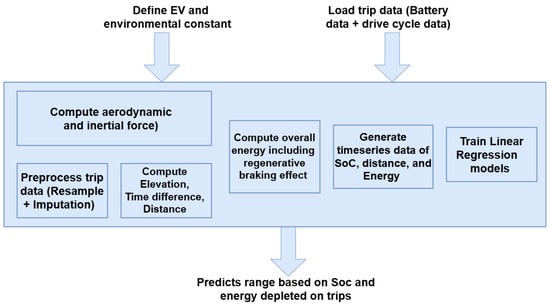
Figure 6.
System architecture and data flow of the driving range prediction system.

Table 2.
Synopsis of the investigated IoT services.
3.2. Power Flow Analysis
The global electrical power industry faces challenges like generation diversification, asset optimization, energy conservation, demand response, and carbon footprint reduction. Efficient energy monitoring and control are crucial for maximizing renewable energy benefits. Power (Sometimes called as load) flow analysis is an essential method for examining power system operation and planning by determining node voltages and branch power flow based on a given generation state and network structure [43]. It provides a steady-state solution, disregarding transient processes, by formulating the problem as a nonlinear algebraic equation derived from Kirchhoff’s Current Law (KCL) at each bus. The Newton–Raphson (NR) method solves these equations using iterative linearization based on Taylor series expansion. The general form of the power flow equations is given as follows:
where are voltage magnitudes at buses i and j, are conductance and susceptance between buses i and j, and is the phase angle difference between buses i and j. After that, NR solves the nonlinear power flow equations iteratively by linearizing them using the Jacobian matrix until the error is within an acceptable threshold.
Figure 7 depicts a block diagram of power flow analysis to calculate power losses in the feeder to know the congestion time (overload time) to reduce energy wastage for distribution system operators. It uses the Newton–Raphson method for power system studies. It begins with the load measurement data of the feeder, including bus data, line data, and load profiles. The next step involves mapping the power grid model, incorporating a slack bus and multiple load buses to represent the network structure. Then, power loss results are initialized, and the Newton–Raphson method is used to iterate over various time steps, solving power flow equations dynamically. The computed results help in analyzing power losses, which are crucial for identifying periods of high congestion. Ultimately, these insights help identify congestion times, enabling effective load management strategies to enhance system efficiency and reliability. The application domain can be easily mapped to the Measurify framework as in Table 3.
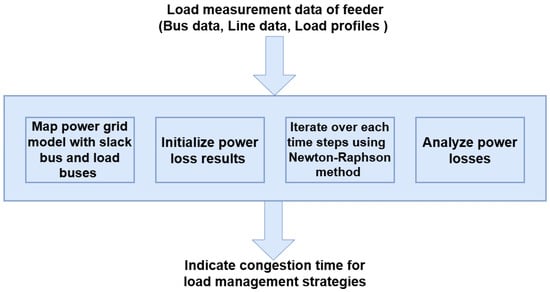
Figure 7.
Power flow analysis for losses calculation.

Table 3.
Characteristics of IoT services and mapping with Measurify resources.
3.3. Appliances Scheduling
Cost-reflective grid tariff designs encourage consumers to reduce peak demand by adjusting their electricity usage patterns, helping to balance the grid more efficiently [44]. As a result, power suppliers implement dynamic electricity tariffs, where prices vary based on demand, promoting cost-effective and sustainable energy consumption. Appliance scheduling services aim to determine the most economical operational schedule for a set of appliances to minimize electricity expenditure. For appliances that have flexibility in starting time and/or other features, the operation dependence of inter-appliance and intra-appliance scheduling is designed to exploit price variation further. The scheduling algorithm changes the power mode of each electric device dynamically. We employ a model predictive control method that utilizes a building energy-management controller (BEMC), as described in [45]. The timeline is divided into fixed-size schedulable slots. The BEMC receives the instantaneous electricity price, operational time, and power consumption rating of each appliance for each time slot, and then solves an optimization problem to minimize the energy cost of electrical appliances across all available time slots. The problem can be formulated as an optimization model to minimize the total electricity cost over a given scheduling horizon.
where is the electricity price at time t, is a appliance signature representing state of load i at time t, is the power consumption of load i. This formulation helps in cost savings of residential occupants by shifting energy-intensive tasks to periods of lower electricity prices.
The methodology for appliance scheduling is based on a combination of descriptive analytics, time series analysis, cost optimization, and decision support systems (DSS) to recommend the most cost-effective hours for using high-power appliances, as shown in Figure 8. Initially, the system aggregates household energy consumption data on an hourly basis and analyses fluctuations in electricity prices to identify cost variations throughout the day. By multiplying hourly energy consumption by corresponding electricity prices, the system calculates the total cost of running appliances at different times. A rule-based decision-making approach is then employed, where hours with the lowest cost per kWh are recommended for operating energy-intensive appliances. This optimized scheduling helps minimize electricity bills and improve overall energy efficiency by shifting appliance usage to off-peak hours with lower rates. The appliance scheduling service seamlessly integrates with the Measurify framework, allowing for efficient mapping and utilization of its features as in Table 3.
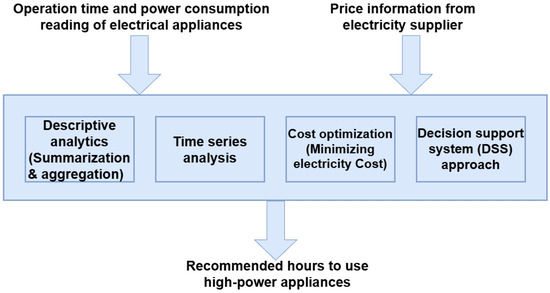
Figure 8.
Structure of appliance schedule model.
3.4. Synopsis
This sub-section synthesizes the characterization of the three services presented above through two synoptic tables. First, Table 2 provides an outlook of the three energy IoT services, where the metamodeling illustrates inputs, outputs, data processing algorithms, stakeholders, benefits and constrains. Then, Table 3 summarizes the main data characteristics and their mapping to Measurify resource types.
The widespread use of IoT for data measurement, combined with the long-term accumulation and large-scale analysis of such data, requires careful definition of sampling rates (typically ranging from a few Hz to several kHz) to avoid both redundancy and the loss of transient, potentially valuable events. Heterogeneity in the measured sensor data is frequent, and can be due to different data sources, network and spatial distribution across the monitored area. These factors introduce synchronization challenges and variability in data collection intervals, especially in dynamic environments or under unreliable network conditions. Such inconsistencies, caused by different sampling rates, node failures, packet loss, or measurement precision, can compromise data quality and hinder practical analysis. To address this, Measurify assigns a unique timestamp to every sample within a measurement, ensuring accurate temporal alignment across heterogeneous data streams. Moreover, each measurement is linked to its source device, which allows spotting and taking into account individual effects (e.g., drift).
4. Experimental Results and Analysis
This section presents the case studies of three services presented in Section 3. Table 4 summarizes the data sources, formats, computational platforms, and previous use of each dataset in similar IoT applications. All computations were performed using Python version 3.12.7, distributed via Anaconda, within the Jupyter Notebook 7.4 environment. Further details for each analysis are provided in the following subsections.

Table 4.
Outlook of experimental tools and conditions.
4.1. Range Prediction
This service validates the range prediction of EVs by using a data-driven energy consumption model explained in Section 3.1. The energy consumption over road segments is estimated by linking it to microscopic driving parameters, environmental data (temperature, elevation), vehicle data (speed, throttle, motor torque, longitudinal acceleration, regenerative braking signal), and battery data (voltage, current, temperature, SoC) as in Equation (2). We utilize the TripA01 battery and heating data from real driving cycles in [46]. The trip took place on 25 June 2019, in the Munich East area, under sunny weather conditions. The journey covered a distance of 7.43 km in 16.82 min. The battery temperature increased from 21.0 °C to 22.0 °C, while the SoC dropped from 86.3% to 80.3%. The ambient temperature at the start was 25.5 °C, with a target cabin temperature of 23.0 °C. The vehicle’s fan operated in automatic mode at Level 1, ensuring optimal cabin conditions throughout the trip. The vehicle specification, driving cycle information and others factor used for range prediction models are provided in Table A1 of Appendix A.
The SoC of the battery pack versus the driving range and energy depletion of EV looks like a straight line in Figure 9. The blue line represents the actual traveled distance in proportion to the decrease in SoC. The red line represents the actual energy depletion, as calculated mechanically. Due to variations in elevation and the effects of regenerative braking, the battery recharges at specific points, causing deviations from a perfectly straight line. However, the yellow dashed line represents the estimated remaining range, which follows a straight-line approximation for generalization. The graph shows a nearly linear trend, indicating a consistent energy consumption pattern throughout the trip. The estimated range based on SoC depletion closely aligns with the actual traveled distance. In contrast, the predicted range and energy depletion closely match real-world data, demonstrating the accuracy of the prediction model. This confirms that range estimation is a reliable tool for trip planning, making it particularly valuable for EV drivers.
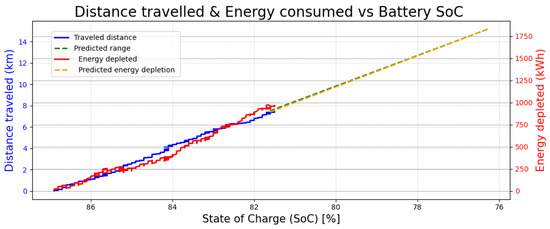
Figure 9.
The relationship between battery SoC, distance traveled, and energy depletion, highlighting the near-linear energy consumption pattern and the accuracy of the predicted range estimation for efficient EV trip planning.
4.2. Power Flow Analysis
The power flow analysis utilizes time-series load shapes for the 55 loads served by the test feeder, with a one-minute time resolution over one day, enabling a detailed assessment of load variations and their impact on grid performance. Figure 10 illustrates the power profile of the Modified European LV test system, showing variations in power multiplier values (in kW) across different load profile nodes over 24 h (measured in minutes) as in Equation (3). The 3D plot highlights fluctuations in power demand across the network. The X-axis represents the load profile across distribution nodes, the Y-axis captures power consumption dynamics over time, and the Z-axis indicates power demand intensity at specific nodes and intervals, in kW. The residential power consumption remains zero for the first 300 min, suggesting a minimal load before 5 AM. Identifying peak demand periods enables the implementation of demand-side management strategies to enhance grid stability.
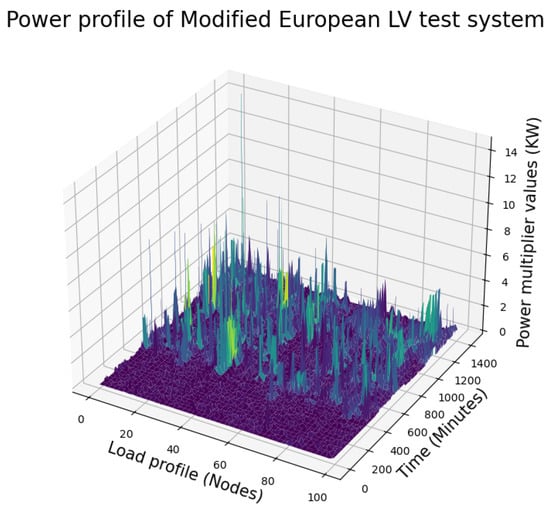
Figure 10.
Load profile of modified European LV test data.
Figure 11 shows the variation in total power losses (in MW) over 24 h. The real power loss in a transmission line connecting bus i and bus j is calculated as , where each term is derived using the bus voltage magnitudes, conductance , susceptance , and the phase angle difference as in Equation (5). The red plot highlights the power loss trend, helping to analyze system efficiency and performance variations over time. A spike in power loss despite no load at feeder nodes before 1 AM could be caused by reactive power flow, transformer/core losses, leakage currents, or system imbalances. Factors like capacitor switching, no-load transformer excitation, or sudden voltage fluctuations may also contribute to these losses. The fluctuations in power losses indicate varying load conditions throughout the day after 6 AM, with noticeable peaks during specific time intervals.
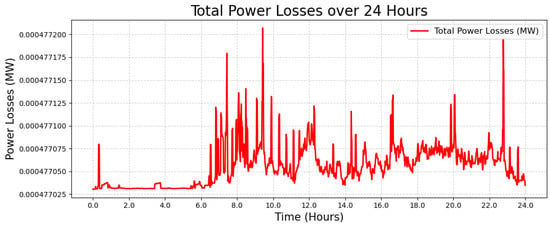
Figure 11.
Daily power losses with one-minute resolution.
Overall, the power loss plot from the load profile analysis provides insights into the variation in power losses over time, highlighting the impact of fluctuating load demand on the distribution system. Peaks in power losses correspond to periods of high demand, indicating increased stress on the network, while lower losses suggest periods of reduced load. Analyzing these trends helps assess system efficiency, identify potential congestion or inefficiencies, and optimize load management strategies to minimize losses and enhance grid performance.
4.3. Appliance Scheduling
Figure 12 illustrates the daily electricity consumption pattern of nine electrical appliances—fridge, dishwasher, microwave, water kettle, washing machine, radio with amplifier, dryer, kitchenware, and bedside light—over a weekday in Building1, a single-floor apartment in Klagenfurt occupied by a young couple who are mostly away on weekdays and spend evenings and weekends at home. Each appliance is represented by a different colour, showing its electrical power usage in watts over time. The data reveal distinct usage signatures, where some appliances operate periodically with sharp peaks (e.g., blue), indicating cyclical or automated use, likely corresponding to devices such as a fridge, while others (e.g., pink, orange, and purple) display sporadic high-power consumption, suggesting short bursts of activity, which is typical of electric kettles, washing machines, dishwashers, and kitchenware. The naming format appears to be a MAC address-like device ID, commonly used in Zigbee-based smart home energy monitoring systems for wireless communication with a central hub. Among high-power-consuming appliances, 000D6F00029C2BD7, 000D6F0003562C48, and 000D6F000353AE51 correspond to the water kettle, dishwasher, and kitchenware (oven), respectively. The pink power pattern, characterized by a short, high-power spike, corresponds to a kettle being used around 7 AM for breakfast preparation. The orange pattern, characterized by an initial high-power phase, a lower-power cycle, and a final high-power phase, corresponds to a washing machine, suggesting operation during off-peak hours to optimize electricity costs. The purple pattern, marked by an initial surge above 2 kW followed by a steady draw of approximately 200 W, is typical of an oven, likely used for evening meal preparation, aligning with typical household cooking routines.
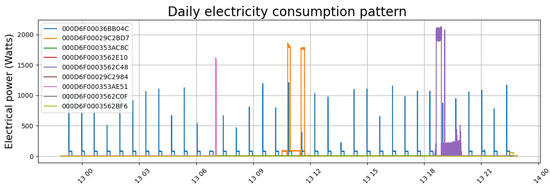
Figure 12.
Energy consumption visualization on house seven in the GREEEND dataset. Diurnal power variation by different electrical appliances over of Building1 on 13 March 2014.
These distinct appliance signatures provide insights into daily household energy usage, helping to identify energy-intensive devices and opportunities for optimizing electricity consumption, such as shifting appliance use to off-peak hours or integrating smart energy-management systems.
Furthermore, to recommend the optimal hours, we utilize rule-based descriptive analytics, as presented in Section 3.3. The prerequisite criteria for appliance scheduling are the day-ahead price and a dynamic structure set daily by the energy market. This study uses the same price data as in [10]. Based on the power ratings of household appliances, their operating durations, and the electricity tariff structure, the analysis suggests that the five optimum recommended hours for electricity usage are 2 AM, 3 AM, 4 AM, 1 AM, and 5 AM, in descending order. These hours likely correspond to off-peak periods, where electricity demand is lower, leading to reduced tariffs, making them optimal for operating high-power appliances such as washing machines, ovens, or water heaters to minimize overall energy costs.
4.4. Measurify Data Uploading
The experimental evaluation of the three energy IoT services aims at assessing the reliability and applicability of the Measurify framework in managing heterogeneous sensor data across various domains. To ensure consistency in latency measurements and eliminate variability caused by network transmission, all tests were performed by deploying a local instance of Measurify directly on the host machine. This set-up avoids the influence of external communication delays, which depend on specific network configurations and hardware, and cannot be generalized a priori. All experiments were conducted on a mid-range laptop equipped with an 11th Gen Intel® Core™ i7-11800H processor (Intel Corporation, Santa Clara, CA, USA) running at 2.30 GHz, 16 GB of RAM, and an NVIDIA RTX 3050 Ti Laptop GPU (NVIDIA Corporation, Santa Clara, CA, USA). This hardware configuration provides a balanced and accessible development environment, ideal for evaluating lightweight IoT middleware, such as Measurify. In addition to performance metrics, Table 5 summarizes the structural characteristics of the datasets used in the three domains, reporting the number of files, columns, total rows, and total file size. This comparison highlights the variety of the datasets and the scalability of the framework.

Table 5.
Overview of dataset structure across the three application domains.
Using Jupyter Notebooks, we performed automated data uploading of the datasets (batch upload), and measured the average latency per file. Additionally, the Docker Desktop tool was used to measure CPU and RAM utilization for each domain. Table 6 reports the average latency and resource usage observed during the experiments.

Table 6.
Measured latency and system resource usage for each IoT service (batch upload).
Results, presented in Table 6, highlight some correlations in the observed performance metrics. First, the observed latency per row depends on the number of columns in each CSV file. For example, the vehicular batteries dataset, despite its relatively modest size in rows, reached the highest latency due to its 38-column structure. In contrast, the LV test feeder dataset, with only two columns per file, had the lowest latency. However, in all tested domains, the measured latencies remain within the range of 90–190 microseconds per row, aligning well with the requirements of real-time processing scenarios.
RAM usage was affected mainly by the total number of rows, particularly in the HEMS dataset, which required more than 3 GB of memory. This is a natural consequence of bulk uploading and processing extensive time-series data. Anyways, this remains acceptable compared to the capacity of a 16 GB RAM computer. CPU usage remains low and relatively constant in all applications, never exceeding 7% average, confirming the lightweight nature of the Measurify architecture.
Besides testing real-time reception of the data, we also performed streaming tests by sending single measurements at controlled frequencies of 1 Hz, 10 Hz, 1000 Hz and 10,000 Hz. Given Measurify’s fast response time (in the order of a few hundred microseconds), no performance degradation or data loss was observed, even at the highest frequency. We omit results in terms of latency, CPU, and RAM usage, as they are similar to those in Table 6 for batch upload. These results confirm the framework’s suitability for real-time monitoring, demonstrating that Measurify can ingest data with latencies below 200 microseconds per row and sustain input rates up to 10,000 Hz without loss. This performance enables low-latency data availability, significantly reducing time-to-insight and supporting the efficient development of energy-focused IoT services.
Overall, the experimental results validate the suitability of a measurement-oriented approach for practical energy-related IoT applications. Measurify’s structured data modeling, RESTful architecture, and automatic schema validation allow for fast prototyping, efficient error handling, and seamless integration with real-world datasets. Its ability to operate within low latency and low resource constraints, demonstrated in these experiments under realistic workloads, confirms its potential for use in production-grade, real-time IoT systems.
4.5. Discussion
The experimental results demonstrate that Measurify is a robust and flexible platform for integrating and managing various types of IoT measurement data in energy-related applications. While the previous sub-section focused on low-level performance metrics, this discussion highlights the broader implications of adopting a measurement-oriented framework and compares Measurify with other state-of-the-art solutions.
Compared to general-purpose IoT architectures, such as OpenIoT, Web of Things, and commercial platforms like AWS IoT and Azure IoT, Measurify offers a lightweight, fully open-source solution that excels in flexibility and semantic clarity. As shown in Table 7, Measurify supports fine-grained modeling of field entities as RESTful web resources, which simplifies integration and encourages modular development. This design enables developers to focus on the application logic, while the framework handles data structure validation, access control, and real-time API exposure.

Table 7.
Representative projects proposing general-purpose and open-source IoT architectures/ platforms.
While Table 7 provides a conceptual comparison, our experimental results (Section 4.4) further validate Measurify’s performance advantages. In particular, we observed sub-millisecond ingestion latency, low CPU/RAM usage, and stable performance up to 10,000 Hz input rates, metrics that are rarely published in evaluations of general-purpose platforms like IoTAWS or MS Azure.
Unlike other platforms that prioritize high-level service interoperability or rely on tightly coupled vendor ecosystems, Measurify provides developers with full control over the data model and resource hierarchy. Its measurement-oriented paradigm, where domain objects, features, and measurements are explicitly defined, proves particularly well-suited to domains characterized by heterogeneous, high-frequency, and time-sensitive data streams, such as battery monitoring, power grid diagnostics, and smart home automation.
One notable advantage is the reduced development overhead. Thanks to its modular API design and automatic data validation mechanisms, Measurify supports rapid prototyping and minimizes the debugging effort. Our experience showed that developers can deploy structured applications within hours, rather than days, and seamlessly scale across multiple devices and sensors. Additionally, recent work described and tested the CSV-based workflow for data integration with MongoDB through Measurify, which improves flexibility and error handling compared to native mongoimport tools [26].
From a scalability perspective, Measurify successfully managed large datasets (including over 18 million rows) and high-frequency data streams (up to 10,000 Hz) without performance degradation. This confirms its potential as a foundational layer for real-time, data-intensive IoT services in the energy domain and beyond.
Nevertheless, the current study has some limitations. The experiments were conducted using a local instance of Measurify, and further validation in distributed or cloud-hosted deployments would provide more general insights into network-related scalability and multi-user performance. Additionally, while Measurify enables effective data modeling and uploading, advanced features such as automated analytics pipelines, anomaly detection modules, or predictive capabilities remain external to the framework and must be developed on top of its APIs.
In summary, the efficient development of data-driven energy applications requires tools, such as Measurify, that can support accurate time-stamped measurements, flexible modeling, scalable real-time data handling, and easy, open deployment.
5. Conclusions and Future Work
As IoT energy data offer a huge potential for new services, suitable application programming interfaces (APIs) for visualization, querying, and exploration are needed for building powerful energy-management applications. Open-source IoT platforms promise to foster a broad range of IoT application services, built on top of a hardware foundation of various sensing and actuation devices. In this context, we have assessed the support for effective and efficient development by a state-of-the-art measurement-oriented modeling and execution framework, such as Measurify. Modeling involves mapping the domain-specific field objects to the Measurify API’s resources. To validate the framework, we have selected three energy domains: vehicular batteries, low-voltage (LV) feeders, and home energy-management systems (HEMS). Thus, we have modeled the three data sources and their measurement contexts onto the five essential resources (thing, feature, service, device, and measurement) of Measurify, assessing its validity in supporting efficient development. Our experience showed that Measurify can seamlessly support a variety of IoT services, providing benefits in terms of effectiveness and efficiency, as its resources support a structured and modular approach to application modeling and development. As for future work is concerned, we argue that key improvements for an efficient measurement-oriented framework include effective data inputation and seamless integration of edge artificial intelligence, particularly unsupervised machine learning, leveraging the power of data, and minimizing the labeling costs.
Author Contributions
Conceptualization, H.D., F.B. and R.B.; methodology, H.D., F.B., M.F., P.D. and R.B.; software, H.D., P.D. and M.F.; validation, H.D., F.B., M.F. and P.D.; formal analysis, H.D., F.B., M.F. and R.B.; investigation, H.D. and F.B.; resources, H.D., F.B., R.B. and M.F.; data curation, H.D. and M.F.; writing—original draft preparation, H.D., F.B., M.F., P.D. and R.B.; writing—review and editing, H.D., F.B., M.F., P.D. and R.B.; visualization, H.D., M.F. and P.D.; supervision, F.B. and R.B.; project administration, F.B. and R.B. All authors have read and agreed to the published version of the manuscript.
Funding
This research received no external funding.
Institutional Review Board Statement
Not applicable.
Informed Consent Statement
Not applicable.
Data Availability Statement
This research uses a publicly available dataset, accessible here: https://catalog.data.gov/dataset/li-ion-battery-aging-datasets (accessed on 24 January 2025). https://ieee-dataport.org/open-access/battery-and-heating-data-real-driving-cycles (accessed on 24 January 2025). https://ieee-dataport.org/open-access/paper-reduced-electrically-equivalent-model-ieee-european-low-voltage-test-feeder (accessed on 24 January 2025). https://www.andreatonello.com/greend-energy-metering-data-set/ (accessed on 24 January 2025).
Conflicts of Interest
The authors declare no conflict of interest.
Appendix A
The range prediction model for electric vehicles (EVs) estimates the driving distance based on energy consumption, vehicle dynamics, environmental conditions, and efficiency factors. This appendix outlines key specifications and constant values used in the prediction calculations.

Table A1.
Vehicle parameters and efficiency factors.
Table A1.
Vehicle parameters and efficiency factors.
| Parameter | Symbol | Value | Unit | Description |
|---|---|---|---|---|
| Gravity | g | 9.81 | m/s2 | Acceleration due to gravity |
| Rolling resistance coefficient | f | 0.01 | – | Resistance between tires and road |
| Aerodynamic drag coefficient | 0.3 | – | Drag coefficient of the vehicle | |
| Frontal area | A | 2.2 | m2 | Vehicle’s frontal cross-sectional area |
| Air density | 1.225 | kg/m3 | Density of air at sea level | |
| Vehicle mass | m | 1500 | kg | Total mass of the EV |
| Rotational equivalent mass | kg | Effective mass considering rotating components | ||
| Headwind velocity | 0 | m/s | Assumed zero for prediction | |
| Drivetrain efficiency | 0.9 | – | Efficiency of power transfer from battery to wheels | |
| Regenerative braking efficiency | 0.7 | – | Efficiency of energy recovery during braking |
References
- Singh, M.; Øvsthus, K.; Kampen, A.L.; Dhungana, H. Development of a human cognition inspired condition management system for equipment. Int. J. Syst. Assur. Eng. Manag. 2024, 1, 1–10. [Google Scholar] [CrossRef]
- Dhungana, H. Rule-Based Decision Making in Biologically Inspired Condition Management System. In Proceedings of the 16th International Conference on Agents and Artificial Intelligence, Rome, Italy, 24–26 February 2024; Volume 2, pp. 1245–1254. [Google Scholar] [CrossRef]
- Dhungana, H. Case based Decision Making in Biologically Inspired Condition Management System. In Proceedings of the 7th International Conference on Inventive Computation Technologies, ICICT 2024, Lalitpur, Nepal, 24–26 April 2024; pp. 335–339. [Google Scholar] [CrossRef]
- Dhungana, H.; Mukhiya, S.K.; Dhungana, P.; Karic, B. Deep learning-based fault identification in condition monitoring. In Proceedings of the Applications in Electronics Pervading Industry, Environment and Society, Turin, Italy, 19–20 September 2024; Ruo Roch, M., Bellotti, F., Berta, R., Martina, M., Ros, P.M., Eds.; Springer: Cham, Switzerland, 2025; pp. 418–428. [Google Scholar] [CrossRef]
- Ul Mehmood, M.; Ulasyar, A.; Khattak, A.; Imran, K.; Zad, H.S.; Nisar, S. Cloud Based IoT Solution for Fault Detection and Localization in Power Distribution Systems. Energies 2020, 13, 2686. [Google Scholar] [CrossRef]
- Almahmoud, Z.; Crandall, J.; Elbassioni, K.; Nguyen, T.T.; Roozbehani, M. Dynamic Pricing in Smart Grids under Thresholding Policies. IEEE Trans. Smart Grid 2019, 10, 3415–3429. [Google Scholar] [CrossRef]
- Zoha, A.; Gluhak, A.; Imran, M.A.; Rajasegarar, S. Non-Intrusive Load Monitoring Approaches for Disaggregated Energy Sensing: A Survey. Sensors 2012, 12, 16838–16866. [Google Scholar] [CrossRef]
- Chen, X.; Wei, T.; Hu, S. Uncertainty-aware household appliance scheduling considering dynamic electricity pricing in smart home. IEEE Trans. Smart Grid 2013, 4, 932–941. [Google Scholar] [CrossRef]
- Stute, J.; Klobasa, M. How do dynamic electricity tariffs and different grid charge designs interact?—Implications for residential consumers and grid reinforcement requirements. Energy Policy 2024, 189, 114062. [Google Scholar] [CrossRef]
- Tezde, E.I.; Okumus, H.I.; Savran, I. Two-Stage Energy Management of Multi-Smart Homes with Distributed Generation and Storage. Electronics 2019, 8, 512. [Google Scholar] [CrossRef]
- Razghandi, M.; Zhou, H.; Erol-Kantarci, M.; Turgut, D. Short-Term Load Forecasting for Smart Home Appliances with Sequence to Sequence Learning. In Proceedings of the IEEE International Conference on Communications, ICC 2021, Montreal, QC, Canada, 14–23 June 2021. [Google Scholar] [CrossRef]
- Zanella, A.; Bui, N.; Castellani, A.; Vangelista, L.; Zorzi, M. Internet of things for smart cities. IEEE Internet Things J. 2014, 1, 22–32. [Google Scholar] [CrossRef]
- Shrouf, F.; Miragliotta, G. Energy management based on Internet of Things: Practices and framework for adoption in production management. J. Clean. Prod. 2015, 100, 235–246. [Google Scholar] [CrossRef]
- Dhungana, H. A machine learning approach for wind turbine power forecasting for maintenance planning. Energy Inform. 2025, 8, 1–25. [Google Scholar] [CrossRef]
- Miranda, M.H.; Silva, F.L.; Lourenço, M.A.; Eckert, J.J.; Silva, L.C. Particle swarm optimization of Elman neural network applied to battery state of charge and state of health estimation. Energy 2023, 285, 129503. [Google Scholar] [CrossRef]
- Wei, H.; He, C.; Li, J.; Zhao, L. Online estimation of driving range for battery electric vehicles based on SOC-segmented actual driving cycle. J. Energy Storage 2022, 49, 104091. [Google Scholar] [CrossRef]
- Adhikaree, A.; Kim, T.; Vagdoda, J.; Ochoa, A.; Hernandez, P.J.; Lee, Y. Cloud-based battery condition monitoring platform for large-scale lithium-ion battery energy storage systems using internet-of-things (IoT). In Proceedings of the 2017 IEEE Energy Conversion Congress and Exposition, ECCE 2017, Cincinnati, OH, USA, 1–5 October 2017; pp. 1004–1009. [Google Scholar] [CrossRef]
- Kobeissi, A.; Bellotti, F.; Berta, R.; De Gloria, A. Towards an IoT-enabled dynamic wireless charging metering service for electrical vehicles. In Proceedings of the 2019 AEIT International Conference of Electrical and Electronic Technologies for Automotive, AEIT AUTOMOTIVE 2019, Turin, Italy, 2–4 July 2019. [Google Scholar] [CrossRef]
- Cirimele, V.; La Ganga, A.; Colussi, J.; Gloria, A.D.; Diana, M.; Bellotti, F.; Berta, R.; Sayed, N.E.; Kobeissi, A.; Guglielmi, P.; et al. The Fabric ICT Platform for Managing Wireless Dynamic Charging Road Lanes. IEEE Trans. Veh. Technol. 2020, 69, 2501–2512. [Google Scholar] [CrossRef]
- Berta, R.; Kobeissi, A.; Bellotti, F.; De Gloria, A. Atmosphere, an Open Source Measurement-Oriented Data Framework for IoT. IEEE Trans. Ind. Inform. 2021, 17, 1927–1936. [Google Scholar] [CrossRef]
- Bellotti, F.; Osman, N.; Arnold, E.H.; Mozaffari, S.; Innamaa, S.; Louw, T.; Torrao, G.; Weber, H.; Hiller, J.; De Gloria, A.; et al. Managing Big Data for Addressing Research Questions in a Collaborative Project on Automated Driving Impact Assessment. Sensors 2020, 20, 6773. [Google Scholar] [CrossRef]
- Capello, A.; Fresta, M.; Bellotti, F.; Haghighi, H.; Hiller, J.; Mozaffari, S.; Berta, R. Exploiting Big Data for Experiment Reporting: The Hi-Drive Collaborative Research Project Case. Sensors 2023, 23, 7866. [Google Scholar] [CrossRef]
- Monteriù, A.; Prist, M.R.; Frontoni, E.; Longhi, S.; Pietroni, F.; Casaccia, S.; Scalise, L.; Cenci, A.; Romeo, L.; Berta, R.; et al. A Smart Sensing Architecture for Domestic Monitoring: Methodological Approach and Experimental Validation. Sensors 2018, 18, 2310. [Google Scholar] [CrossRef]
- Ehsan, A.; Abuhaliqa, M.A.M.E.; Catal, C.; Mishra, D. RESTful API Testing Methodologies: Rationale, Challenges, and Solution Directions. Appl. Sci. 2022, 12, 4369. [Google Scholar] [CrossRef]
- Fresta, M.; Bellotti, F.; Capello, A.; Cossu, M.; Lazzaroni, L.; De Gloria, A.; Berta, R. Efficient Uploading of .Csv Datasets into a Non-Relational Database Management System. In Proceedings of the Applications in Electronics Pervading Industry, Environment and Society, Genoa, Italy, 26–27 September 2022; Berta, R., De Gloria, A., Eds.; Springer: Cham, Switzerland, 2023; pp. 9–15. [Google Scholar] [CrossRef]
- Fresta, M.; Capello, A.; Bellotti, F.; Lazzaroni, L.; Cossu, M.; Berta, R. Supporting a .csv-based Workflow in MongoDB for Data Analysts. In Proceedings of the IEEE International Symposium on Industrial Electronics, Helsinki, Finland, 19–21 June 2023. [Google Scholar] [CrossRef]
- Lu, L.; Han, X.; Li, J.; Hua, J.; Ouyang, M. A review on the key issues for lithium-ion battery management in electric vehicles. J. Power Sources 2013, 226, 272–288. [Google Scholar] [CrossRef]
- Xiong, R.; Cao, J.; Yu, Q.; He, H.; Sun, F. Critical Review on the Battery State of Charge Estimation Methods for Electric Vehicles. IEEE Access 2017, 6, 1832–1843. [Google Scholar] [CrossRef]
- Lyne, N. Optimizing Precision Cell Measurement Accuracy in Automotive Battery Management Systems. 1 November 2020. Available online: https://www.powersystemsdesign.com/articles/optimizing-precision-cell-measurement-accuracy-in-automotive-battery-management-systems/145/15772 (accessed on 22 October 2024).
- Gallinaro, S. Higher Reliability, Safety, and 30% Longer Lifetime with Advanced Battery Management in Healthcare Energy Storage Systems. 2019. Available online: https://www.analog.com/en/resources/technical-articles/higher-reliability-safety-and-30-longer-lifetime-with-advanced-battery-management.html (accessed on 23 October 2024).
- Schneider, K.P.; Mather, B.A.; Pal, B.C.; Ten, C.W.; Shirek, G.J.; Zhu, H.; Fuller, J.C.; Pereira, J.L.; Ochoa, L.F.; De Araujo, L.R.; et al. Analytic Considerations and Design Basis for the IEEE Distribution Test Feeders. IEEE Trans. Power Syst. 2018, 33, 3181–3188. [Google Scholar] [CrossRef]
- Wagle, R.; Sharma, P.; Sharma, C.; Amin, M. Optimal power flow based coordinated reactive and active power control to mitigate voltage violations in smart inverter enriched distribution network. Int. J. Green Energy 2024, 21, 359–375. [Google Scholar] [CrossRef]
- Ni, F.; Nguyen, P.H.; Cobben, J.F.; Van den Brom, H.E.; Zhao, D. Three-phase state estimation in the medium-voltage network with aggregated smart meter data. Int. J. Electr. Power Energy Syst. 2018, 98, 463–473. [Google Scholar] [CrossRef]
- Himeur, Y.; Alsalemi, A.; Bensaali, F.; Amira, A. Smart non-intrusive appliance identification using a novel local power histogramming descriptor with an improved k-nearest neighbors classifier. Sustain. Cities Soc. 2021, 67, 102764. [Google Scholar] [CrossRef]
- Ruano, A.; Hernandez, A.; Ureña, J.; Ruano, M.; Garcia, J. NILM Techniques for Intelligent Home Energy Management and Ambient Assisted Living: A Review. Energies 2019, 12, 2203. [Google Scholar] [CrossRef]
- Hart, G.W. Nonintrusive Appliance Load Monitoring. Proc. IEEE 1992, 80, 1870–1891. [Google Scholar] [CrossRef]
- De Cauwer, C.; Verbeke, W.; Coosemans, T.; Faid, S.; Van Mierlo, J. A Data-Driven Method for Energy Consumption Prediction and Energy-Efficient Routing of Electric Vehicles in Real-World Conditions. Energies 2017, 10, 608. [Google Scholar] [CrossRef]
- Varga, B.O.; Sagoian, A.; Mariasiu, F. Prediction of Electric Vehicle Range: A Comprehensive Review of Current Issues and Challenges. Energies 2019, 12, 946. [Google Scholar] [CrossRef]
- Hannan, M.A.; Lipu, M.S.; Hussain, A.; Mohamed, A. A review of lithium-ion battery state of charge estimation and management system in electric vehicle applications: Challenges and recommendations. Renew. Sustain. Energy Rev. 2017, 78, 834–854. [Google Scholar] [CrossRef]
- Saha, B.; Goebel, K. Battery Data Set; NASA Ames Research Center: Moffett Field, CA, USA, 2007; Available online: https://phm-datasets.s3.amazonaws.com/NASA/5.+Battery+Data+Set.zip (accessed on 22 October 2024).
- Tannahill, V.R.; Muttaqi, K.M.; Sutanto, D. Driver alerting system using range estimation of electric vehicles in real time under dynamically varying environmental conditions. IET Electr. Syst. Transp. 2016, 6, 107–116. [Google Scholar] [CrossRef]
- De Cauwer, C.; Verbeke, W.; Van Mierlo, J.; Coosemans, T. A Model for Range Estimation and Energy-Efficient Routing of Electric Vehicles in Real-World Conditions. IEEE Trans. Intell. Transp. Syst. 2020, 21, 2787–2800. [Google Scholar] [CrossRef]
- Wang, X.F.; Song, Y.; Irving, M. Load Flow Analysis. In Modern Power Systems Analysis; Springer: Boston, MA, USA, 2008; pp. 71–128. [Google Scholar] [CrossRef]
- Hofmann, M.; Bjarghov, S.; Sæle, H.; Lindberg, K.B. Grid tariff design and peak demand shaving: A comparative tariff analysis with simulated demand response. Energy Policy 2025, 198, 114475. [Google Scholar] [CrossRef]
- Chen, C.; Wang, J.; Heo, Y.; Kishore, S. MPC-based appliance scheduling for residential building energy management controller. IEEE Trans. Smart Grid 2013, 4, 1401–1410. [Google Scholar] [CrossRef]
- Steinstraeter, M.; Buberger, J.; Trifonov, D. Battery and Heating Data in Real Driving Cycle; IEEE DataPort: New York, NY, USA, 2020. [Google Scholar] [CrossRef]
- Khan, M.A.; Hayes, B.P. For Paper “A Reduced Electrically-Equivalent Model of the IEEE European Low Voltage Test Feeder”; IEEE DataPort: New York, NY, USA, 2020. [Google Scholar] [CrossRef]
- Monacchi, A.; Egarter, D.; Elmenreich, W.; D’Alessandro, S.; Tonello, A.M. GREEND: An energy consumption dataset of households in Italy and Austria. In Proceedings of the 2014 IEEE International Conference on Smart Grid Communications, SmartGridComm 2014, Venice, Italy, 3–6 November 2014; pp. 511–516. [Google Scholar] [CrossRef]
- Steinstraeter, M.; Buberger, J.; Minnerup, K.; Trifonov, D.; Horner, P.; Weiss, B.; Lienkamp, M. Controlling cabin heating to improve range and battery lifetime of electric vehicles. eTransportation 2022, 13, 100181. [Google Scholar] [CrossRef]
- OpenIoT. Available online: https://www.openiot.eu/ (accessed on 22 October 2024).
- Home—Web of Things (WoT). Available online: https://www.w3.org/WoT/ (accessed on 22 October 2024).
- Introduction—BIG IoT. Available online: https://big-iot.eu/ (accessed on 22 October 2024).
- IoT Edge. Open Source Edge—AWS IoT Greengrass—AWS. Available online: https://aws.amazon.com/iot/ (accessed on 22 October 2024).
- Azure IoT—Internet of Things Platform. Available online: https://azure.microsoft.com/en-gb (accessed on 22 October 2024).
Disclaimer/Publisher’s Note: The statements, opinions and data contained in all publications are solely those of the individual author(s) and contributor(s) and not of MDPI and/or the editor(s). MDPI and/or the editor(s) disclaim responsibility for any injury to people or property resulting from any ideas, methods, instructions or products referred to in the content. |
© 2025 by the authors. Licensee MDPI, Basel, Switzerland. This article is an open access article distributed under the terms and conditions of the Creative Commons Attribution (CC BY) license (https://creativecommons.org/licenses/by/4.0/).